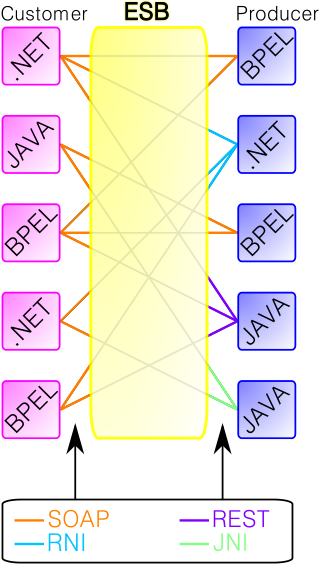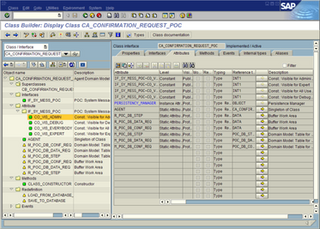Related Research Articles

Oracle Corporation is an American multinational computer technology company headquartered in Austin, Texas. In 2020, Oracle was the third-largest software company in the world by revenue and market capitalization. In 2023, the company’s seat in Forbes Global 2000 was 80. The company sells database software and cloud computing. Oracle's core application software is a suite of enterprise software products, such as enterprise resource planning (ERP) software, human capital management (HCM) software, customer relationship management (CRM) software, enterprise performance management (EPM) software, Customer Experience Commerce and supply chain management (SCM) software.
Middleware in the context of distributed applications is software that provides services beyond those provided by the operating system to enable the various components of a distributed system to communicate and manage data. Middleware supports and simplifies complex distributed applications. It includes web servers, application servers, messaging and similar tools that support application development and delivery. Middleware is especially integral to modern information technology based on XML, SOAP, Web services, and service-oriented architecture.

A public key infrastructure (PKI) is a set of roles, policies, hardware, software and procedures needed to create, manage, distribute, use, store and revoke digital certificates and manage public-key encryption.
SAP R/3 is the former name of the enterprise resource planning software produced by the German corporation SAP AG. It is an enterprise-wide information system designed to coordinate all the resources, information, and activities needed to complete business processes such as order fulfillment, billing, human resource management, and production planning.

An enterprise service bus (ESB) implements a communication system between mutually interacting software applications in a service-oriented architecture (SOA). It represents a software architecture for distributed computing, and is a special variant of the more general client-server model, wherein any application may behave as server or client. ESB promotes agility and flexibility with regard to high-level protocol communication between applications. Its primary use is in enterprise application integration (EAI) of heterogeneous and complex service landscapes.
SAP NetWeaver is a software stack for many of SAP SE's applications. The SAP NetWeaver Application Server, sometimes referred to as WebAS, is the runtime environment for the SAP applications and all of the mySAP Business Suite runs on SAP WebAS: supplier relationship management (SRM), customer relationship management (CRM), supply chain management (SCM), product lifecycle management (PLM), enterprise resource planning (ERP), transportation management system (TMS).
Enterprise software, also known as enterprise application software (EAS), is computer software used to satisfy the needs of an organization rather than its individual users. Enterprise software is an integral part of a computer-based information system, handling a number of business operations, for example to enhance business and management reporting tasks, or support production operations and back office functions. Enterprise systems must process information at a relatively high speed.

Profinet is an industry technical standard for data communication over Industrial Ethernet, designed for collecting data from, and controlling equipment in industrial systems, with a particular strength in delivering data under tight time constraints. The standard is maintained and supported by Profibus and Profinet International, an umbrella organization headquartered in Karlsruhe, Germany.

SAP GUI is the graphical user interface client in SAP ERP's 3-tier architecture of database, application server and client. It is software that runs on a Microsoft Windows, Apple Macintosh or Unix desktop, and allows a user to access SAP functionality in SAP applications such as SAP ERP and SAP Business Information Warehouse (BW). It is used for remote access to the SAP central server in a company network.
SAP NetWeaver Application Server or SAP Web Application Server is a component of SAP NetWeaver which works as a web application server for SAP products. All ABAP application servers including the message server represent the application layer of the multitier architecture of an ABAP-based SAP system. These application servers execute ABAP applications and communicate with the presentation components, the database, and also with each other, using the message server.
SAP NetWeaver Master Data Management (SAP NW MDM) is a component of SAP's NetWeaver product group and is used as a platform to consolidate, cleanse and synchronise a single version of the truth for master data within a heterogeneous application landscape. It has the ability to distribute internally and externally to SAP and non-SAP applications. SAP MDM is a key enabler of SAP Service-Oriented Architecture. Standard system architecture would consist of a single central MDM server connected to client systems through SAP Exchange Infrastructure using XML documents, although connectivity without SAP XI can also be achieved. There are five standard implementation scenarios:
- Content Consolidation - centralised cleansing, de-duplication and consolidation, enabling key mapping and consolidated group reporting in SAP BI. No re-distribution of cleansed data.
- Master Data Harmonisation - as for Content Consolidation, plus re-distribution of cleansed, consolidated master data.
- Central Master data management - as for Master Data Harmonisation, but all master data is maintained in the central MDM system. No maintenance of master data occurs in the connected client systems.
- Rich Product Content Management - Catalogue management and publishing. Uses elements of Content Consolidation to centrally store rich content (images, PDF files, video, sound etc.) together with standard content in order to produce product catalogues (web or print). Has standard adapters to export content to Desktop Publishing packages.
- Global Data Synchronization - provides consistent trade item information exchange with retailers through data hubs (e.g. 1SYNC)

SAP ERP is an enterprise resource planning software developed by the German company SAP SE. SAP ERP incorporates the key business functions of an organization. The latest version of SAP ERP (V.6.0) was made available in 2006. The most recent SAP enhancement package 8 for SAP ERP 6.0 was released in 2016. It is now considered legacy technology, having been superseded by SAP S/4HANA.
SAP Solution Manager is a product developed by the software company SAP SE. It offers end-to-end application lifecycle management to streamline business processes and proactively address improvement options, increasing efficiency and decreasing risk within SAP customers' existing maintenance agreements and managing the application lifecycle.
SAP Business Connector is a re-branded version/restricted licence version of webMethods Integration Server provided by SAP as a middleware solution for their R/3 product. It was developed jointly by webMethods and SAP in a partnership which lasted from March 1999 to March 2002. webMethods contributed the Integration Server platform, while SAP contributed the components for RFC/tRFC, BAPI and IDoc communication and processing. These SAP components were bundled into an add-on package that can be installed on top of the core Integration Server.
The SAP NetWeaver Development Infrastructure ("NWDI") combines the characteristics and advantages of local development environments – as usually provided in a Java environment – with a server-based development landscape that centrally provides a consistent development environment to development teams and supports the software development through the entire lifecycle of a product.
SAP NetWeaver Visual Composer is SAP’s web-based software modelling tool. It enables business process specialists and developers to create business application components, without coding.
SAP NetWeaver Portal is one of the building blocks in the SAP NetWeaver architecture. With a Web Browser, users can begin work once they have been authenticated in the portal which offers a single point of access to information, enterprise applications, and services both inside and outside an organization. The portal provides access to business processes and information, social collaboration and content management across various consumption channels.
SAP Logon Tickets represent user credentials in SAP systems. When enabled, users can access multiple SAP applications and services through SAP GUI and web browsers without further username and password inputs from the user. SAP Logon Tickets can also be a vehicle for enabling single sign-on across SAP boundaries; in some cases, logon tickets can be used to authenticate into 3rd party applications such as Microsoft-based web applications.
BRFplus is a business rule management system (BRMS) offered by SAP AG. BRFplus is part of the SAP NetWeaver ABAP stack. Therefore, all SAP applications that are based on SAP NetWeaver can access BRFplus within the boundaries of an SAP system. However, it is also possible to generate web services so that BRFplus rules can also be offered as a service in a SOA landscape, regardless of the software platform used by the service consumers.